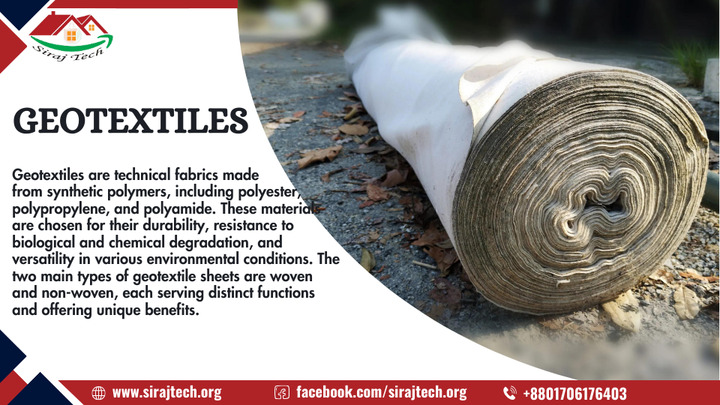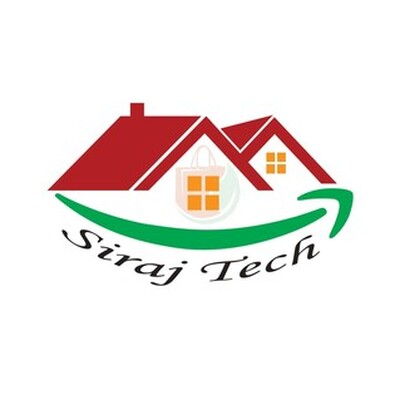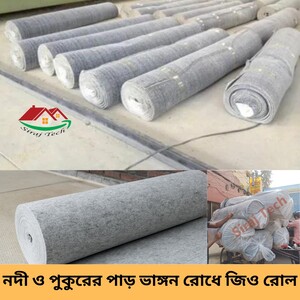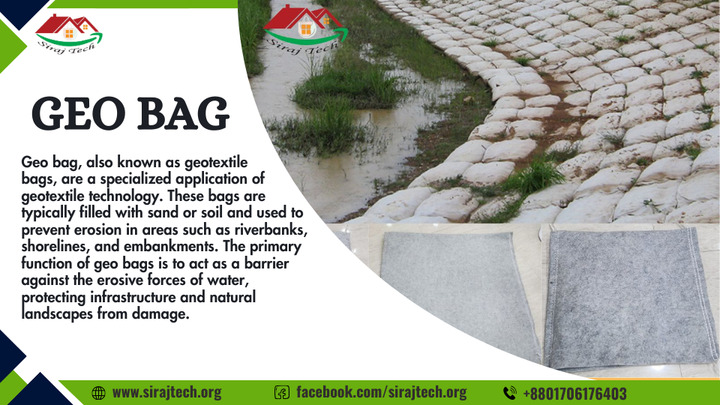Cuerpo
Geotextiles and Geobags: Revolutionizing Civil Engineering and Construction
Geotextiles and Geobags have emerged as groundbreaking solutions in civil engineering and construction. These materials, primarily made from polyester, polypropylene, and polyamide, have transformed the landscape of soil reinforcement, erosion control, and infrastructural stability. In this expanded discussion, we'll delve deeper into the composition, types, applications, and advantages of geotextiles and geobags, while also exploring their significance in modern construction projects.
Composition and Types of Geotextiles
Geotextiles are technical fabrics made from synthetic polymers, including polyester, polypropylene, and polyamide. These materials are chosen for their durability, resistance to biological and chemical degradation, and versatility in various environmental conditions. The two main types of geotextile sheets are woven and non-woven, each serving distinct functions and offering unique benefits.
Woven Geotextiles
Woven geotextiles are created by weaving individual threads of plastic in a manner similar to traditional fabric weaving. This process results in a strong, durable material that provides substantial support and stability. The primary advantage of woven geotextiles lies in their tensile strength, making them ideal for applications requiring reinforcement and load distribution. They are commonly used in road construction, embankment stabilization, and other applications where soil strength is crucial.
Non-Woven Geotextiles
Non-woven geotextiles, on the other hand, are manufactured through a process called needle-punching or heat-bonding. This technique involves entangling synthetic fibers to create a fabric that excels in filtration and drainage applications. Non-woven geotextiles are particularly effective in preventing soil erosion and maintaining water flow in areas prone to flooding. Their porous structure allows water to pass through while retaining soil particles, making them essential for applications like riverbank protection and drainage systems.
Geobags: An Innovative Erosion Control Solution
Geobags, also known as geotextile bags, are a specialized application of geotextile technology. These bags are typically filled with sand or soil and used to prevent erosion in areas such as riverbanks, shorelines, and embankments. The primary function of geobags is to act as a barrier against the erosive forces of water, protecting infrastructure and natural landscapes from damage.
Geobags offer several advantages over traditional erosion control methods. They are flexible, easy to install, and can conform to various shapes and contours. This adaptability makes them suitable for use in complex and irregular terrains. Additionally, geobags can be vegetated to enhance their stability and aesthetic appeal, promoting ecological restoration alongside structural protection.
Understanding GSM: Grams per Square Meter
A crucial factor in the selection and application of geotextiles is their weight, measured in Grams per Square Meter (GSM). GSM indicates the mass of the geotextile material per square meter of area, which correlates with the thickness and durability of the fabric. Higher GSM values generally signify thicker, stronger materials that offer greater reinforcement and longevity.
The following are approximate thicknesses for various GSM values:
- 200 GSM** = 2 mm
- 300 GSM** = 2.5 mm
- 400 GSM** = 3 mm
- 500 GSM** = 3.8 mm
- 600 GSM** = 4.5 mm
The choice of GSM depends on the specific requirements of the project. For instance, lower GSM geotextiles (e.g., 200 GSM) might be used for applications requiring filtration and drainage, while higher GSM geotextiles (e.g., 600 GSM) are suitable for heavy-duty reinforcement and erosion control.
Applications of Geotextiles and Geobags
Geotextiles and geobags are employed in a wide range of civil engineering and construction projects. Their versatility and effectiveness make them indispensable in modern infrastructure development. Some of the key applications include:
Road Construction
In road construction, geotextiles are used to enhance the structural integrity of the pavement. They are placed between the subgrade soil and the aggregate base to prevent soil mixing and improve load distribution. This not only extends the lifespan of the road but also reduces maintenance costs. Geotextiles also act as a barrier against water infiltration, preventing the weakening of the subgrade and ensuring long-term stability.
Embankment and Slope Stabilization
Geotextiles are crucial in stabilizing embankments and slopes, especially in areas with loose or weak soils. By reinforcing the soil and providing a stable foundation, geotextiles help prevent landslides and erosion. They also facilitate vegetation growth, which further stabilizes the soil and enhances the natural landscape.
Drainage Systems
Non-woven geotextiles are widely used in drainage systems due to their excellent filtration properties. They allow water to pass through while retaining soil particles, preventing clogging and ensuring efficient drainage. This is particularly important in applications such as retaining walls, landfill liners, and agricultural drainage.
Erosion Control
Geobags are specifically designed for erosion control in areas exposed to water flow, such as riverbanks, shorelines, and coastal regions. By forming a protective barrier, geobags prevent soil erosion and protect infrastructure from water damage. They can also be used in conjunction with other erosion control measures, such as riprap and vegetative cover, to enhance their effectiveness.
Land Reclamation
In land reclamation projects, geotextiles and geobags play a vital role in creating stable foundations and preventing soil erosion. They are used to reinforce the reclaimed land and provide a stable base for construction activities. This is particularly important in coastal areas where land reclamation is essential for urban development and infrastructure expansion.
Geotechnical Engineering
Geotextiles are extensively used in geotechnical engineering to improve soil properties and enhance the stability of structures. They are used in the construction of retaining walls, foundation stabilization, and soil reinforcement. By providing additional strength and support, geotextiles help prevent structural failures and ensure the longevity of the infrastructure.
Advantages of Geotextiles and Geobags
The use of geotextiles and geobags offers numerous advantages in civil engineering and construction:
- Enhanced Soil Stability: Geotextiles reinforce the soil, improving its load-bearing capacity and preventing subsidence. This is crucial in areas with weak or unstable soils.
- Erosion Control: Geobags provide effective erosion control, protecting infrastructure and natural landscapes from water damage. Their flexibility and adaptability make them suitable for various terrains.
- Improved Drainage: Non-woven geotextiles excel in filtration and drainage applications, ensuring efficient water flow and preventing soil erosion.
- Cost-Effective: Geotextiles are lightweight and easy to transport, reducing installation costs and time. Their durability and longevity also result in long-term cost savings.
- Environmental Benefits: Geotextiles promote ecological restoration by facilitating vegetation growth and reducing soil erosion. This enhances the natural landscape and supports biodiversity.
- Versatility: Geotextiles and geobags can be used in a wide range of applications, from road construction to coastal protection. Their adaptability makes them suitable for various project requirements.
Procuring Geotextiles and Geobags
For those looking to procure geotextiles and geobags in Bangladesh, there are reliable suppliers offering high-quality products with 100% assurance. Interested parties can contact suppliers via phone or WhatsApp to inquire about pricing and availability. One such contact number is +8801706176403.
In conclusion, geotextiles and geobags represent a harmonious fusion of necessity and innovation in civil engineering and construction. These materials have revolutionized the way we approach soil reinforcement, erosion control, and infrastructure development. By understanding their composition, types, applications, and advantages, we can fully appreciate their significance in shaping a more stable and sustainable built environment.












Comentarios